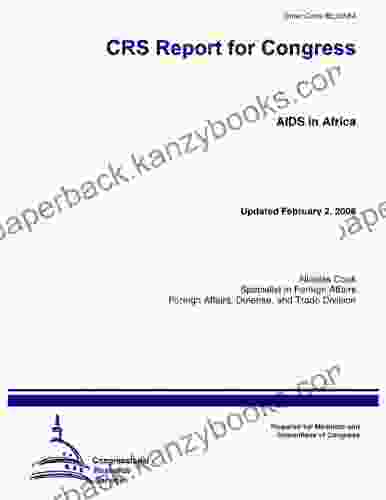AIDS in Africa: A Comprehensive Guide to Prevention, Treatment, and Care

AIDS is a major public health challenge in Africa, with an estimated 25.7 million people living with HIV in 2020. The region accounts for over two-thirds of the global burden of HIV/AIDS, and the epidemic has had a devastating impact on the social and economic development of many African countries.
5 out of 5
| Language | : | English |
| File size | : | 209 KB |
| Text-to-Speech | : | Enabled |
| Screen Reader | : | Supported |
| Enhanced typesetting | : | Enabled |
| Word Wise | : | Enabled |
| Print length | : | 34 pages |
| Lending | : | Enabled |
This comprehensive guide provides essential information on AIDS in Africa for healthcare professionals and policymakers working in the region. It covers the following topics:
- The epidemiology of HIV/AIDS in Africa
- The clinical presentation and diagnosis of HIV/AIDS
- The prevention of HIV/AIDS
- The treatment of HIV/AIDS
- The care of people living with HIV/AIDS
This guide is based on the latest scientific evidence and best practices, and it is written in a clear and accessible style. It is an essential resource for anyone working to address the challenge of AIDS in Africa.
Epidemiology of HIV/AIDS in Africa
The epidemiology of HIV/AIDS in Africa is complex and varies from country to country. However, some general trends can be observed.
- HIV prevalence is highest in southern Africa, where it is estimated that one in four adults is living with HIV.
- HIV prevalence is also high in eastern and central Africa, where it is estimated that one in ten adults is living with HIV.
- HIV prevalence is lower in western and northern Africa, but it is still a major public health concern in these regions.
The HIV epidemic in Africa is driven by a number of factors, including:
- Poverty and inequality: Poverty and inequality are major drivers of HIV transmission in Africa. People living in poverty are more likely to be exposed to HIV through unprotected sex, injection drug use, or blood transfusions.
- Weak health systems: Health systems in Africa are often weak and underfunded, which makes it difficult for people to access HIV prevention, treatment, and care services.
- Stigma and discrimination: Stigma and discrimination against people living with HIV/AIDS is a major barrier to prevention, treatment, and care.
Clinical Presentation and Diagnosis of HIV/AIDS
The clinical presentation of HIV/AIDS varies depending on the stage of the infection. In the early stages, HIV infection may be asymptomatic or may cause only mild symptoms, such as fever, fatigue, and sore throat. As the infection progresses, more severe symptoms may develop, such as:
- Weight loss
- Diarrhea
- Pneumonia
- Kaposi's sarcoma
HIV/AIDS can also lead to a number of opportunistic infections, which are caused by bacteria, viruses, or fungi that take advantage of the weakened immune system. These opportunistic infections can be serious and even life-threatening.
The diagnosis of HIV/AIDS is based on a blood test that detects antibodies to HIV. A positive HIV test result means that the person has been infected with HIV and is at risk of developing AIDS.
Prevention of HIV/AIDS
There is no cure for HIV/AIDS, but there are a number of effective ways to prevent transmission of the virus. These include:
- Condom use: Condoms are the most effective way to prevent HIV transmission during sex.
- Pre-exposure prophylaxis (PrEP): PrEP is a medication that can be taken by HIV-negative people to reduce their risk of acquiring HIV through sex or injection drug use.
- Post-exposure prophylaxis (PEP): PEP is a medication that can be taken by HIV-negative people who have been exposed to HIV to reduce their risk of acquiring the virus.
- Voluntary medical male circumcision: Voluntary medical male circumcision (VMMC) is a surgical procedure that can reduce the risk of HIV transmission from men to women.
In addition to these biomedical interventions, there are also a number of behavioral interventions that can help to prevent HIV transmission. These include:
- Abstinence: Abstinence from sex is the only 100% effective way to prevent HIV transmission.
- Being faithful: Being faithful to one uninfected partner can help to reduce the risk of HIV transmission.
- Reducing the number of sexual partners: Reducing the number of sexual partners can help to reduce the risk of HIV transmission.
- Avoiding high-risk sexual practices: Avoiding high-risk sexual practices, such as anal sex and unprotected sex, can help to reduce the risk of HIV transmission.
Treatment of HIV/AIDS
There is no cure for HIV/AIDS, but there are effective treatments that can help to suppress the virus and prevent the development of AIDS. These treatments are called antiretroviral therapy (ART).
ART is a combination of medications that work together to block the replication of HIV. ART can help to keep the virus under control and prevent it from damaging the immune system.
ART is typically taken once or twice a day and can be taken for life. It is important to take ART exactly as prescribed in Free Download to ensure that the virus is suppressed and the immune system is protected.
ART has been shown to dramatically improve the health and quality of life of people living with HIV/AIDS. It can help to prevent the development of AIDS-defining illnesses, such as pneumonia and Kaposi's sarcoma, and it can also reduce the risk of death from HIV-related causes.
Care of People Living with HIV/AIDS
In addition to medical treatment, people living with HIV/AIDS also need access to a range of other services, such as:
- Counseling: Counseling can help people living with HIV/AIDS to cope with the psychological and emotional challenges of living with the virus.
- Nutritional support: Nutritional support can help people living with HIV/AIDS to maintain a healthy weight and boost their immune system.
- Social support: Social support can help people living with HIV/AIDS to connect with others who are going through similar experiences and build a sense of community.
- Shelter: Shelter is an important need for people living with HIV/AIDS, especially those who are homeless or living in unstable housing.
- Legal services: Legal services can help people living with HIV/AIDS to access their rights and protect themselves from discrimination.
A comprehensive approach to care for people living with HIV/AIDS is
5 out of 5
| Language | : | English |
| File size | : | 209 KB |
| Text-to-Speech | : | Enabled |
| Screen Reader | : | Supported |
| Enhanced typesetting | : | Enabled |
| Word Wise | : | Enabled |
| Print length | : | 34 pages |
| Lending | : | Enabled |
Do you want to contribute by writing guest posts on this blog?
Please contact us and send us a resume of previous articles that you have written.
 Book
Book Novel
Novel Page
Page Chapter
Chapter Text
Text Story
Story Genre
Genre Reader
Reader Library
Library Paperback
Paperback E-book
E-book Magazine
Magazine Newspaper
Newspaper Paragraph
Paragraph Sentence
Sentence Bookmark
Bookmark Shelf
Shelf Glossary
Glossary Bibliography
Bibliography Foreword
Foreword Preface
Preface Synopsis
Synopsis Annotation
Annotation Footnote
Footnote Manuscript
Manuscript Scroll
Scroll Codex
Codex Tome
Tome Bestseller
Bestseller Classics
Classics Library card
Library card Narrative
Narrative Biography
Biography Autobiography
Autobiography Memoir
Memoir Reference
Reference Encyclopedia
Encyclopedia Howie Southworth
Howie Southworth Phil Cousineau
Phil Cousineau Y S Lee
Y S Lee Matthew Guay
Matthew Guay Little Mat
Little Mat Richard Wolffe
Richard Wolffe Sigal Adler
Sigal Adler Tessa Austin
Tessa Austin Matt Stanton
Matt Stanton Tiffany Lazic
Tiffany Lazic Rick Shapiro
Rick Shapiro Lucy Jones
Lucy Jones Joan Mullally
Joan Mullally Samir Maktouf
Samir Maktouf Todd Nyholm
Todd Nyholm Tony Hampton Md
Tony Hampton Md Nan Lewis Doerr
Nan Lewis Doerr Sandy Schwartz
Sandy Schwartz Mike Julian
Mike Julian Mark Monmonier
Mark Monmonier
Light bulbAdvertise smarter! Our strategic ad space ensures maximum exposure. Reserve your spot today!

 Forrest BlairSimple Guide to Thyroiditis Diagnosis, Treatment, and Related Disorders: A...
Forrest BlairSimple Guide to Thyroiditis Diagnosis, Treatment, and Related Disorders: A...
 Alan Turner2100 Days of Easy, Delicious, and Low-Cost Dishes: Shed Pounds by Harnessing...
Alan Turner2100 Days of Easy, Delicious, and Low-Cost Dishes: Shed Pounds by Harnessing... Michael ChabonFollow ·18.5k
Michael ChabonFollow ·18.5k John UpdikeFollow ·3.3k
John UpdikeFollow ·3.3k Todd TurnerFollow ·6.9k
Todd TurnerFollow ·6.9k Albert CamusFollow ·14.7k
Albert CamusFollow ·14.7k Everett BellFollow ·9.9k
Everett BellFollow ·9.9k Bernard PowellFollow ·5.9k
Bernard PowellFollow ·5.9k Dominic SimmonsFollow ·10k
Dominic SimmonsFollow ·10k James GrayFollow ·18.1k
James GrayFollow ·18.1k

 Tyrone Powell
Tyrone PowellUnlock the Secrets of Consciousness and Infinite...
In the realm of...

 Devin Ross
Devin RossUnlock the Power of Nature: Discover the Transformative...
Embrace a Healthier Tomorrow with...

 Stan Ward
Stan WardUnveiling the Treasures of Pescatarian Cuisine: A...
Are you ready to...

 Edward Bell
Edward BellBreak Free from the Chains of Sexual Addiction: A...
Sexual addiction, a relentless and...

 Wayne Carter
Wayne CarterTantalizing Treats from Paradise: Hawaiian Desserts for...
Embark on a Culinary Journey to the Islands...
5 out of 5
| Language | : | English |
| File size | : | 209 KB |
| Text-to-Speech | : | Enabled |
| Screen Reader | : | Supported |
| Enhanced typesetting | : | Enabled |
| Word Wise | : | Enabled |
| Print length | : | 34 pages |
| Lending | : | Enabled |










